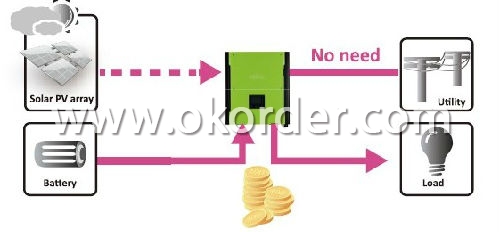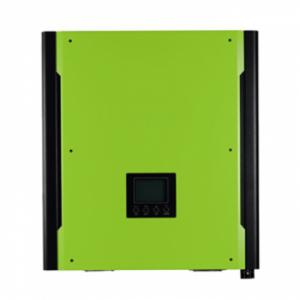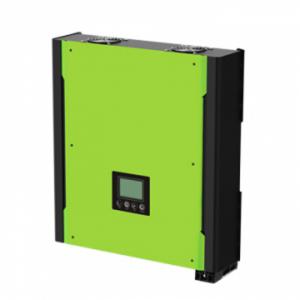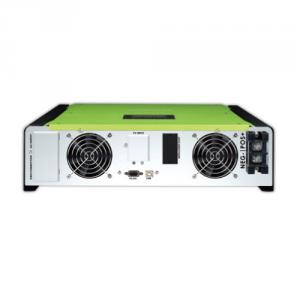On-Grid Inverter With Energy Storage 2000W
- Loading Port:
- Shenzhen
- Payment Terms:
- TT or LC
- Min Order Qty:
- 1 Unit pc
- Supply Capability:
- 8000 Units/month pc/month
OKorder Service Pledge
OKorder Financial Service
You Might Also Like
Description of On-Grid Inverter With Energy Storage 2000W
1.Pure sine wave output
2.Microprocessor controlled to guarantee stable charging system
3.Multiple operations: Grid tie, Off grid, and grid tie with backup
4.Built-in MPPT solar charger
5.LCD display panel for comprehensive information
6.Multiple communication
7.Green substitution for generators
8.User adjustable charging current up to 25A
Feed-in is not only choice
In comparison with conventional grid-tie inverter, CNBM hybrid inverter is able to not only feed-in power to grid but also store solar power to battery for future usage and directly power to the loads.

Save money by discharging battery for self-consumption first
CNBM hybrid inverter can save money by using battery energy first when PV energy is low. Until battery energy is low, CNBM will extract AC power from the grid.

Power backup when AC failed
CNBM hybrid inverter can operate as an off-grid inverter to provide continuous power even without the grid.
It's perfect power solution for remote regions or temporary AC power source such as camping or flea market.

Datasheet of On-Grid Inverter With Energy Storage 2000W
MODEL | CNBM-H 2KW | CNBM-H 3KW |
RATED POWER | 2000W | 3000W |
GRID-TIE OPERATION | ||
PV INPUT (DC) | ||
Maximum DC power | 2250W | 3200W |
Nominal DC voltage / Maximum DC voltage | 300 VDC / 350VDC | 360 VDC / 500VDC |
Start voltage / Initial Feeding Voltage | 80 VDC / 120VDC | 116 VDC / 150 VDC |
MPP voltage range | 150 VDC ~ 320 VDC | 250 VDC ~ 450 VDC |
Number of MPP Trackers / Max. input current | 1 / 1×15A | 1 / 1×13A |
GRID OUTPUT (AC) | ||
Nominal Output Voltage | 101/110/120/127 VAC | 208/220/230/240 VAC |
Output Voltage Range | 88 - 127 VAC | 184 – 264.5 VAC |
Nominal Output Current | 18 A | 13.1 A |
Power Factor | > 0.99 | |
EFFICIENCY | ||
Maximum Conversion Efficiency (DC/AC) | 95% | 96% |
European Efficiency@ Vnominal | 94% | 95% |
OFF-GRID OPERATION | ||
AC INPUT | ||
AC Startup Voltage / Auto Restart Voltage | 60 - 70 VAC / 85VAC | 120 - 140 VAC / 180VAC |
Acceptable Input Voltage Range | 85 - 130 VAC | 170 - 280 VAC |
Maximum AC Input Current | 30A | 25A |
PV INPUT (DC) | ||
Maximum DC voltage | 350 VAC | 500 VAC |
MPP Voltage Range | 150 VAC ~ 320 VDC | 250 VAC ~ 450 VDC |
Maximum Input Current | 1 / 1×15A | 1 / 1×13A |
BATTERY MODE OUTPUT (AC) | ||
Nominal Output Voltage | 101/110/120/127 VAC | 208/220/230/240 VAC |
Output Frequency | 50 Hz / 60 Hz (auto sensing) | |
Output Waveform | Pure sine wave | |
Efficiency (DC to AC) | 90% | 93% |
HYBRID OPERATION | ||
PV INPUT (DC) | ||
Nominal DC voltage / Maximum DC voltage | 300 VDC / 350VDC | 360 VDC / 500VDC |
Start voltage / Initial Feeding Voltage | 80 VDC / 120VDC | 116 VDC / 150 VDC |
MPP voltage range | 150 VDC ~ 320 VDC | 250 VDC ~ 450 VDC |
Maximum Input Current | 1 / 1×15A | 1 / 1×13A |
GRID OUTPUT (AC) | ||
Nominal Output Voltage | 101/110/120/127 VAC | 208/220/230/240 VAC |
Output Voltage Range | 88 - 127 VAC | 184 – 264.5 VAC |
Nominal Output Current | 18 A | 13.1 A |
AC INPUT | ||
AC Startup Voltage / Auto Restart Voltage | 60 - 70 VAC / 85VAC | 120 - 140 VAC / 180VAC |
Acceptable Input Voltage Range | 85 - 130 VAC | 170 - 280 VAC |
Maximum AC Input Current | 30A | 25A |
BATTERY MODE OUTPUT (AC) | ||
Nominal Output Voltage | 101/110/120/127 VAC | 208/220/230/240 VAC |
Efficiency (DC to AC) | 90% | 93% |
BATTERY & CHARGER | ||
Nominal DC Voltage | 48 VDC | |
Maximum Charging Current | 25A | |
GENERAL | ||
PHYSICAL | ||
Dimension, D X W X H (mm) | 420 x 415 x 170 | |
Net Weight (kgs) | 15.5 | |
INTERFACE | ||
Communication Port | RS-232 / USB | |
Intelligent Slot | Optional SNMP, Modbus, and AS400 cards available | |
ENVIRONMENT | ||
Humidity | 0 ~ 90% RH (No condensing) | |
Operating Temperature | 0 to 40°C | |
Altitude | 0 ~ 1000 m | |
COMPLIANCE | ||
Standard | CE, VDE 0126-1-1,VDE-AR-N 4105 | |
- Q:What is the role of a bypass switch in a solar inverter?
- The role of a bypass switch in a solar inverter is to provide a means for redirecting the flow of electricity in case of an emergency or failure within the inverter. It allows for the direct connection of the solar panels to the utility grid, bypassing the inverter, ensuring a continuous supply of electricity even when the inverter is not functioning properly. This helps maintain the stability and reliability of the solar power system.
- Q:What is the role of a solar inverter in voltage support?
- The role of a solar inverter in voltage support is to convert the direct current (DC) produced by solar panels into alternating current (AC) that can be used by the electrical grid. Additionally, it helps regulate and stabilize the voltage levels, ensuring that the electricity generated from solar power is compatible with the grid's voltage requirements.
- Q:Can a solar inverter be used with a three-phase electrical system?
- Yes, a solar inverter can be used with a three-phase electrical system. In fact, many commercial and industrial solar installations use three-phase inverters to convert the direct current (DC) power generated by solar panels into alternating current (AC) power that can be used by the electrical grid. This allows for efficient power conversion and distribution in three-phase systems, which are commonly used in larger electrical installations.
- Q:How does a solar inverter handle voltage transients?
- A solar inverter handles voltage transients by regulating and stabilizing the incoming DC voltage from the solar panels, and converting it into a steady AC voltage suitable for use in the electrical grid or for powering appliances. It uses various electronic components and control algorithms to monitor and adjust the voltage levels, ensuring that any sudden changes or fluctuations in the input voltage are smoothed out and the output remains consistent and within acceptable limits.
- Q:Can a solar inverter be used with different AC voltages?
- Yes, a solar inverter can be used with different AC voltages. However, it is important to ensure that the inverter is compatible with the specific AC voltage and frequency requirements of the power grid it will be connected to.
- Q:Can a solar inverter be used with a battery backup system?
- Yes, a solar inverter can be used with a battery backup system. The solar inverter converts the DC power generated by the solar panels into AC power that can be used to power appliances and charge batteries. The battery backup system stores excess solar energy for use during times when the sun is not shining, providing a reliable source of power even when the solar panels are not producing electricity.
- Q:Can a solar inverter be used in systems with different module tilts?
- Yes, a solar inverter can be used in systems with different module tilts. Solar inverters are designed to convert the DC power generated by solar modules into AC power that can be used in electrical systems. They are typically compatible with a wide range of module tilts and orientations. However, it is important to ensure that the inverter is properly configured to match the specific tilt angles of the solar modules for optimal performance and maximum energy generation.
- Q:What is the role of a galvanic isolation transformer in a solar inverter?
- The role of a galvanic isolation transformer in a solar inverter is to provide electrical isolation between the input (solar panels) and the output (power grid). This isolation helps in preventing any electrical noise, surges, or ground loops from affecting the solar inverter or the power grid, ensuring safe and reliable operation. Additionally, the galvanic isolation transformer helps in maintaining the required level of insulation and protection, complying with safety standards and regulations.
- Q:What is the role of a solar inverter in preventing system downtime?
- The role of a solar inverter in preventing system downtime is to convert the direct current (DC) produced by solar panels into alternating current (AC) that can be used to power electrical devices and to feed excess energy back into the grid. By maintaining a stable and reliable flow of electricity, solar inverters help prevent disruptions and downtime in the solar energy system, ensuring continuous operation and maximizing energy efficiency.
- Q:Can a solar inverter be used with a solar-powered pool heating system?
- Yes, a solar inverter can be used with a solar-powered pool heating system. The solar inverter is responsible for converting the direct current (DC) generated by the solar panels into alternating current (AC) that can be used to power various devices, including pool heating systems.
1. Manufacturer Overview |
|
|---|---|
| Location | Shenzhen,China |
| Year Established | 2010 |
| Annual Output Value | 50 million USD |
| Main Markets | Australia, Euro, America, China. |
| Company Certifications | CE, VDE-AR-N4105, FCC,ETL,CEC,CEI 0-21,G83,G59,SAA,CGC |
2. Manufacturer Certificates |
|
|---|---|
| a) Certification Name | |
| Range | |
| Reference | |
| Validity Period | |
3. Manufacturer Capability |
|
|---|---|
| a)Trade Capacity | |
| Nearest Port | Shenzhen, Guangzhou, Hongkong |
| Export Percentage | 60% |
| No.of Employees in Trade Department | 260 |
| Language Spoken: | English, Chinese |
| b)Factory Information | |
| Factory Size: | 500-1000 |
| No. of Production Lines | 8 |
| Contract Manufacturing | None |
| Product Price Range | 300-40000 USD |
Send your message to us
On-Grid Inverter With Energy Storage 2000W
- Loading Port:
- Shenzhen
- Payment Terms:
- TT or LC
- Min Order Qty:
- 1 Unit pc
- Supply Capability:
- 8000 Units/month pc/month
OKorder Service Pledge
OKorder Financial Service
Similar products
New products
Hot products
Related keywords






























